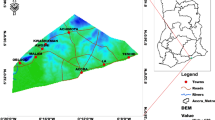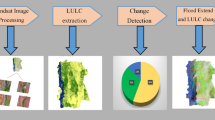Abstract
In the Jeddah region of Saudi Arabia, disastrous flash floods frequently occurred during the last few decades. Short-spelled torrential heavy-rains were considered the main reason for flash floods, which led to high water levels in “urban centers” situated along coastal plains of the Red Sea as well as high-gradient terrains of large braided wadi networks. These flash floods caused enormous fatalities related to lives, properties, and city utilities. It looks impossible to avoid flash flood risks and/or prevent their occurrences under prevailing climatic conditions, but it is possible to mitigate their adverse impacts on city life and property provided interactive relationship between flash flood attitudes and urban development planning are known clearly. This research study was conducted based on extracted wadi courses using SRTM-DEM data and archive geological published maps, modern Jeddah city-map, high-resolution mosaics depicting Jeddah geomorphology, and GIS-linked thematic layers/models. In the integrated research approach, it was evaluated the results from natural and cultural phenomena. Eastern parts of the catchment and terrain of wadis found plutonic igneous rock that resists water percolation and allows runoff from upstream to downstream, resulting in severe flooded conditions. These models revealed extents of extracted historical-imprints of wadi’s flooded courses on the modern city expansion in the Jeddah basin. Comparison indicated that most of the natural drainages and landscape features were bulldozed during Jeddah’s modernization activities. It was also deduced that unanticipated huge construction was another factor aggravating devastation by flash floods in the Jeddah basin. These findings seem to be imperative to reconsider for the formulation of intelligent mitigation plans and redesigning/modifications of new urban settlements.













Similar content being viewed by others
References
Abdullah S (2013) Rise in Jeddah’s population is a strain on its resources. Arab News, 25 January. 2013 http://www.arabnews.com/saudi-arabia/rise-jeddah%E2%80%99s-population-strain-its-resources. Accessed on July 9, 2017
Aburizaiza OS, Zaigham NA, Nayyar ZA, Mahar GA, Siddiq A, Noor S, (2014) Appraisal of groundwater resource in crystalline hard-rocks of Arabian Shield in wadis of Makkah-Jeddah and their surrounding areas (Phase-I), King Abdulaziz University Approved by King Abdulaziz City for Science & Technology, KACST-8-WAT-140-3,492p.
Accu W (2009) Thoughts on the Jeddah Flash Flood. Accuweather, December 01:2009
AECOM (2011a) Hydrologic and hydraulic modeling: Phase-I large scale hydrology, WER06-REP-0040-C.
AECOM (2011b) AECOM announced today that it was awarded a substantial work order for project management services that include a consultancy, engineering, and construction services contract for a citywide storm water, flood-control, and wastewater infrastructure improvement program in Jeddah, Saudi Arabia: Sun, 2011-05-01, https://aecom.com/sa/press-releases/aecom-announced-today-that-it-was-awarded-a-substantial-work-order-for-project-management-services-that-include-a-consultancy-engineering-and-construction-services-contract-for-a-citywide-storm-wate/ accessed on December 16, 2020
AECOM (2020) Jeddah Stormwater Drainage Programme, Jeddah, Kingdom of Saudi Arabia: AECOM Website, https://publications.aecom.com/water/managing-flood-risk/projects/jeddah-stormwater-drainage-programme. Accessed on December 16, 2020.
Al-Ahmad A (2009) Jeddah flood deaths shame Saudi royals. Guardian, 3 December, 2009.
Alharbi TH (1989) The development of housing in Jeddah: changes in built from the traditional to the modern, School of Architecture. University of Newcastle, England, 434 pages
Al-Saud M (2010) Assessment of Flood Hazard of Jeddah Area 2009, Saudi Arabia. Journal of Water Resource and Protection 2:839–847. https://doi.org/10.4236/jwarp.2010.29099 Published Online September
Ameur F (2016) Floods in Jeddah, Saudi Arabia: Unusual Phenomenon and Huge Losses, What Prognoses: E3S Web of Conferences, 04019, FLOODrisk 2016 - 3rd European Conference on Flood Risk Management 7 0704019. https://doi.org/10.1051/e3sconf/2016
Aziz HFA (2006) Floods in the Holy City of Makkah: Saudi Historical Society. Historical Researches 21st issue, 142p.
Behairy AKA, Sheppard CRC, El-Sayed MK (1992) A review of the geology of coral reefs in the Red Sea. UNEP Regional seas reports and studies:152 41p
Brisitsh BC (2010) Saudi flood deaths 'rise to around100. BBC News, 28-November, 2010.
Conan-Davies R (2017) Floods: A handy reference website, Richard Conan-Davies (ed.), 2 May 2004, updated: 19 July 2009.
Davies R (2013) Jeddah Flood Defenses. Floodlis July 28, 2013.
Despotovic J, Plavsic J, Stefanovic N, Pavlovic D (2005) Inefficiency of storm water inlets as a source of urban floods. Water Science and Technolog. 15(2):139–145
Djordjevic S, Prodanovic D, Maksimovic C, Ivetic M, Savic D (2005) SIPSON – simulation of interaction between pipe flow and surface overland flow in networks. Water Sci Technol 5(5):275–283
Earth Explorer United State Geological Survey (2020), 2.169.0-192-gaf8aa11-0 (2021-02-10 07:58), FS; 083-00
Facey W (2005) Queen of the India trade: Saudi Aramco World. 56(6): 10-16, Nov/Dec. 2005.
Fleitmann D, Matter A, Pint JJ, Al-Shanti MA (2004) The Speleothem Record of Climate Change in Saudi Arabia, Saudi Geological Survey Open-File Report SGS-OF-2004-8, 40p.
Humaidan M (2009) “Jeddah flood toll 106, Arab news, 29 November 2009.
Jeddah Population city (2017) Jeddah City. January 1:2015
Johnson PR (2006) Explanatory notes to the map of Proterozoic geology of western Saudi Arabia. Saudi Geological Survey, Technical Report SGS-TR-2006-4, (2006).
Lendering J (2009) Nabataeans: an Arabian nation in modern Jordan; their capital was Petra, Livius.org, January 2009.
Lin X (1999) Flash floods in arid and semi-arid zones: IHP-V, Technical Documents in Hydrology. 23, 65p, UNESCO, Paris.
Maghrabi K (2012) Impact of Flood Disaster on the Mental Health of Residents in the Eastern Region of Jeddah Governorate, 2010; A Study in medical geography. Life Sci J 9(1):95–110
Maksimovic C, Prodanovic D, Boonya-Aroonnet S, Leitao JP, Djordjevic S, Allitt R (2009) Overland flow and pathway analysis for modelling of urban pluvial flooding. J Hydraul Res 2009 47(4):512–523
MOH (2017) History of Jeddah: Ministry of Hajj (MOH). Hajj Services, National Tawaf Providers.:2016–2017
Murphy C (2009) Saudi Arabians use Facebook to vent fury over Jeddah flood deaths: The Christian Science Monitor. July 01:2017
NSSL (2017), Flood Basics: Severe Weather 101, NOAA National Severe Storms Laboratory, 120 David L. Boren Blvd., Norman, OK 73072, USA
Ortega JA, Razola L, Garzon G (2014) Recent human impacts and change in dynamics and morphology of ephemeral rivers. Nat Hazards Earth Syst Sci 14:713–730
PME (2005) First National Communication on Kingdom of Saudi Arabia. Presidency of Meteorology and Environment, Riyadh, KSA, submitted to the UNFCCC, 142p.
Segev A (2003) Flood basalts, continental breakup and the dispersal of Gondwana: evidence for periodic migration of upwelling mantle flows (plumes). EGU Stephan Mueller Special Publication Series 2:171–191
Shiladitya D (2009) A geological study of Saudi Arabia-particularly the Red Sea margin:
Simmon R, Riebeek H (2010) Flooding in Pakistan, Nasa, Image of the Day. August 24:2010
Stern R, Johnson P (2010) Continental lithosphere of the Arabian Plate: A geologic, petrologic, and geophysical synthesis. Earth-Science Reviews 101:29–67
Stevens J, Carlowicz M (2015) Historic Rainfall Floods Southeast India. NASA, Image if the Day, December 9:2015
Stevens J, Allen J, Hansen K (2016) Flooding on the Lower Mississippi. NASA, Image of the Day, January 16:2016
Subyani AM (2009) Hydrologic behavior and flood probability for selected arid basins in Makkah area, western Saudi Arabia. Arab J Geosci 4:817–824. https://doi.org/10.1007/s12517-009-0098-1
Subyani AM (2012) Flood Hazards Analysis of Jeddah City, Western Saudi Arabia: JAKU. Earth Sci 23(1):35–48. https://doi.org/10.4197/Ear.23-1.3
ten Veldhuis JAE, Clemens FHLR (2011) The efficiency of asset management strategies to reduce urban flood risk. Water Science and Technology. 64(6):1317–1324
Toumi H (2015) Flash floods turn deadly in Jeddah: Gulf news. November 17:2015
Wikipedia (2017a) Jeddah: https://en.wikipedia.org/wiki/Jedda Accessed on July 18, 2017
Wikipedia (2017b) Jeddah in 1924: https://upload.wikimedia.org/wikipedia/commons/9/98/Jeddah_1924.jpg, [accessed on 27th June 2017]
Youssef AM, Sefry SA, Pradhan B, Alfadail EA (2016) Analysis on causes of flash flood in Jeddah city (Kingdom of Saudi Arabia) of 2009 and 2011 using multi-sensor remote sensing data and GIS: Geomatics. Natural Hazards and Risk 7(3):1018–1042
Zaigham NA, Mallick KA (2000) Prospect of hydrocarbon associated with fossil-rift structures of the southern Indus basin, Pakistan. AAPG Bull 84(11):1833–1848
Acknowledgements
The authors are thankful to Prof. Abdulrehman Obaid Al-Youbi, President, King Abdulaziz University, for his support in the smooth execution of the research study. The authors pay thanks to Prof. Khalil A. Mallick, University of Karachi, Pakistan, for the technical review of the manuscript. The authors acknowledge the contribution of Earth Explorer (earthexplorer.usgs.gov) of United State Geological Survey (USGS) that provided the satellite images for the study. Authors also acknowledge the contribution of Google Earth for making data available for the study.
Funding
This study is financially supported by King Abdulaziz City for Science & Technology.
Author information
Authors and Affiliations
Corresponding author
Ethics declarations
Conflict of interest
The authors declare that they have no conflict of interest.
Additional information
Responsible Editor: Broder J. Merkel
Rights and permissions
About this article
Cite this article
Zaigham, N.A., Mahar, G.A., Aburizaiza, O.S. et al. Historical flood imprints reveal factors causing catastrophic impacts on modern Jeddah, Saudi Arabia: a case of flash floods versus rapid urbanization. Arab J Geosci 14, 342 (2021). https://doi.org/10.1007/s12517-021-06703-5
Received:
Accepted:
Published:
DOI: https://doi.org/10.1007/s12517-021-06703-5




